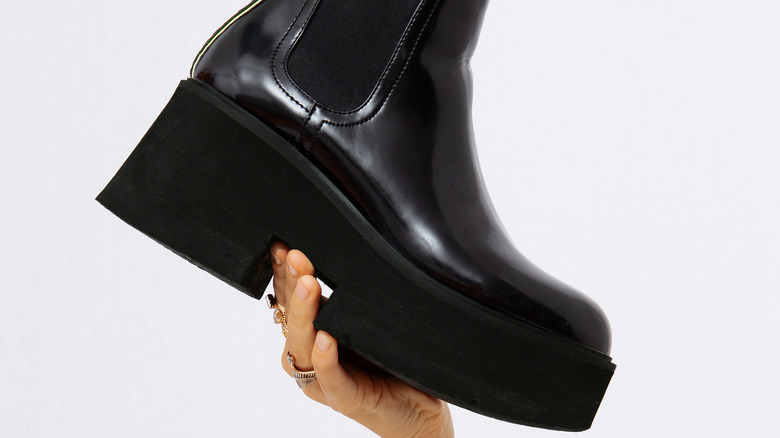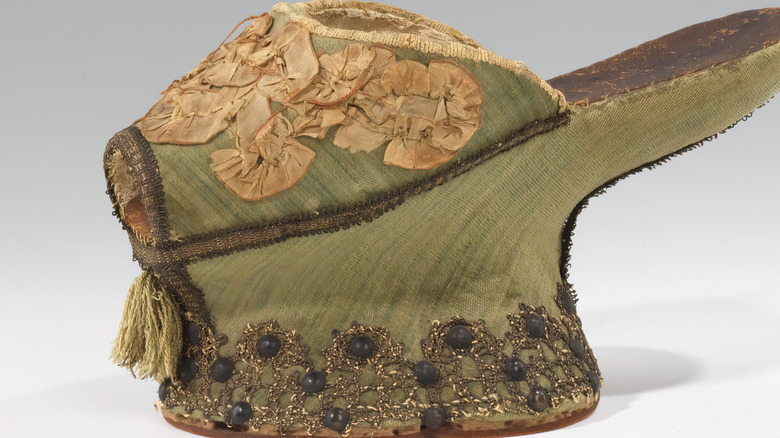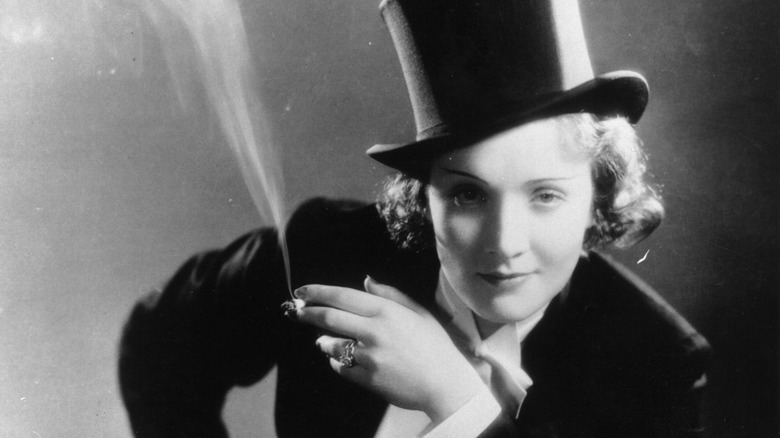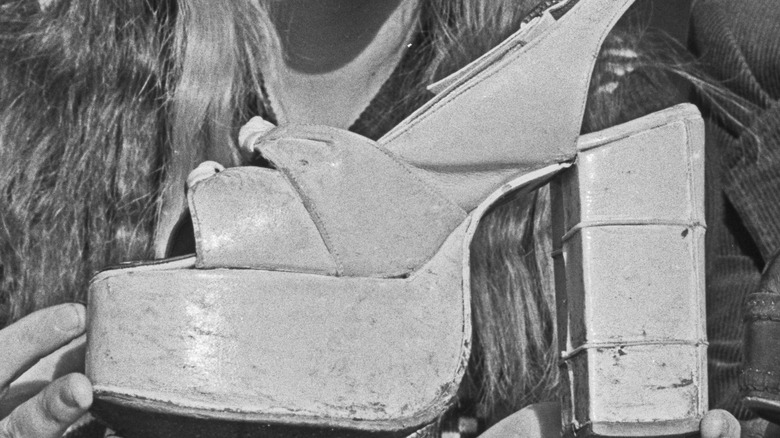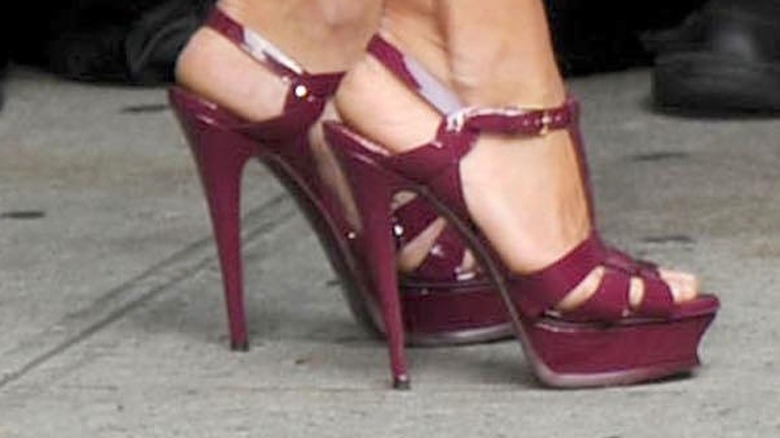What Happened To Platform Shoes?
From ancient Greece to the disco dance floor, platform shoes have a history as big as they are. And, like their sometimes cork or rubber soles, they have an incredible ability to bounce back. The first platforms were worn around B.C. 600, according to Interview, when ancient Greek actors wore them to appear taller on stage. These early platforms were made out of cork and called the cothurnus, according to Mental Itch. The more important role an actor played, the taller their cothurnus.
Platforms' next major appearance came during the Heian Period in Japan, from 794 to 1192, Japan Zone said. During this time, a type of raised wooden clog called a geta emerged. Getas were made from a flat piece of wood and two slats about an inch-and-a-half to two inches high and were worn to keep kimonos from dragging in the mud. Avoiding dirt was also the motive behind the Middle Eastern kabkabs, which emerged during the 13th century, according to Mental Itch. People wore them to keep their feet above mud and water when using public toilets, and they were named for the clapping sound they made on the ground. Kabkabs looked similar to getas in that they were shoes raised on stilts, according to Mic.
High society
The next development in the evolution of the platform shoe was the patten, according to Mic. This was a wood or metal platform that could be attached to women's and men's shoes in Medieval Europe in order to protect the wearers' feet from the mud, dirt, and feces that befouled public roads in the era before modern plumbing. Pattens were worn by all classes of society, Mental Itch pointed out. However, they did develop a certain reputation. Some Christian churches in England forbid their priests from wearing them because they were too over-the-top, according to Interview.
Even more ostentatious was the chopine, a special platform shoe worn by Italian nobles in the 13th century that was often decorated with jewels, according to Mental Itch. During the 15th century, Spain put most of its cork toward the platforms of its own chopines, Interview said. The trend spread to France in 1547, when Catherine de Medici introduced them, Mental Itch said. Wearing taller chopines soon became a status symbol, according to Mic. In Venice, the higher the status a courtesan enjoyed, the taller their shoes. Napoleón apparently wore a pair of chopines almost 30 inches tall, reports Mic.
Star power
People continued to wear pattens into the early 20th century, according to Interview. It was during this century that the platforms we are familiar with today emerged, and they were instantly associated with the rich and famous. The first pair was designed by Moshe Kimel for the actress Marlene Dietrich in the 1930s, according to Mental Itch. Then, in 1938, Salvatore Ferragamo designed a platform called "The Rainbow" in honor of Judy Garland and her performance of "Somewhere Over the Rainbow."
Ferragamo's shoe consisted of a gold sandal over a cork platform with an arched heel covered in layers of leather in different colors, as shown in an image from The Met. Ferragamo used cork because of rationing due to World War II, according to Interview. "The Rainbow" was designed to lift the heel only slightly above the toes, according to The Met. For the rest of the 1940s, however, platforms were designed with a high arch. The shoes fell from fashion in the 1950s, according to Mental Itch. During this decade, the stiletto heel was queen, Interview said. However, platforms were soon to reemerge in their most iconic form.
Disco fever
Platforms reached their "peak" during the 1960s to the 1980s, Interview said. Their popularity was spread by trendy stores like London's Biba boutique and by famous musicians including Gene Simmons, David Bowie, Stevie Nicks, Elton John, and George Clinton. The platform craze started in the UK and Europe before crossing the pond to the U.S., according to Mental Itch. At first, they were mostly worn by teenage girls and young women, but men got in on the fun soon.
Platforms were especially associated with disco, so much so that they came to be called the "party shoe." And they lived up to their name. People wore platforms that were covered in glitter or lights. Some even had tiny aquariums in their heels! The most popular style was the Kork-Ease, which was a wedge heel sandal with quarter straps. However, during this time several other styles took off including platform sneakers and espadrilles, Interview said. They were commonly paired with miniskirts or bell-bottoms, according to Mic. Beyond disco culture, platforms were also embraced by punk, ska, rockabilly, and heavy metal, especially as metal-studded black boots, according to Interview.
Girl power
The platform's first major comeback moment was in the 1990s. Vivienne Westwood designed a platform shoe called the Super Elevated Gillie that had a 5-inch platform and a 9-inch heel, according to Interview. This shoe became infamous when model Naomi Campbell tripped on the runway while wearing them in 1993, according to BBC News. They were blue with false crocodile print.
However, the 1990s celebrities most responsible for the platforms' comeback were the Spice Girls. The girl group wore platform sneakers designed by Buffalo that spawned many imitators, according to Vogue. Ginger Spice, who wore red, white, and blue platforms, was especially associated with the shoes, according to Mic. The shoes became must-have items for teenage girls, who could buy them from stores like Limited Too and Delia's. 1990s designers stuck a platform on almost every type of shoe, as Bustle points out, from sneakers to boots to oxfords to flip-flops. Steve Madden was one brand that designed a popular platform flip-flop, according to Harper's Bazaar.
21st-century shoes
Since the 1990s, platforms have had so many comeback moments that it's hard to say they ever truly went away. The Yves Saint Laurent Tribute sandal is a platform that first debuted in 2004, according to High Heels Daily. Vogue called the sandals "the most copied shoes of recent years," and they are popular with stars from Kate Moss to Tilda Swinton. The 2010s saw the emergence of the flatform, a sandal or oxford raised on a platform with no incline, according to Refinery 29. Platforms are associated with pop star Lady Gaga, who owns a pair of Alexander McQueen's Armadillo boots, according to Interview.
In recent years, 1990s-style platforms, in particular, have begun to make a comeback. Steve Madden reintroduced its platform flip-flops in 2019, as Harper's Bazaar reported. And Spice-Girl-style platforms were popular during London Fashion Week for the spring and summer of 2021, Vogue said. In general, though, platforms are considered a fashion staple, and Refinery 29 guesses that most women own some type of platform pump. As Paola Antonelli, Senior Curator in the Museum of Modern Art's Department of Architecture and Design, told Interview, "Platforms are, as a typology, in constant tension between timelessness and temporality."
